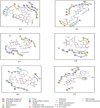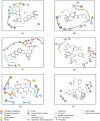Identification of natural inhibitors against prime targets of SARS-CoV-2 using molecular docking, molecular dynamics simulation and MM-PBSA approaches
- PMID: 33183178
- PMCID: PMC7678369
- DOI: 10.1080/07391102.2020.1846624
Identification of natural inhibitors against prime targets of SARS-CoV-2 using molecular docking, molecular dynamics simulation and MM-PBSA approaches
Abstract
The recently emerged COVID-19 has been declared a pandemic by the World Health Organization as to date; no therapeutic drug/vaccine is available for the treatment. Due to the lack of time and the urgency to contain the pandemic, computational screening appears to be the best tool to find a therapeutic solution. Accumulated evidence suggests that many phyto-compounds possess anti-viral activity. Therefore, we identified possible phyto-compounds that could be developed and used for COVID-19 treatment. In particular, molecular docking was used to prioritize the possible active phyto-compounds against two key targets namely RNA dependent RNA polymerase (RdRp) and main protease (Mpro) of SARS-CoV-2. In this study, an antiviral drug- Remdesivir (RdRp inhibitor) and Darunavir (Mpro inhibitor) are used as reference drugs. This study revealed that phyto-molecules- Mulberroside-A/C/E/F, Emblicanin A, Nimbolide, and Punigluconin showed high binding affinity against RdRp while Andrographolides, Mulberrosides, Anolignans, Chebulic acid, Mimusopic acid, and Punigluconin showed better binding affinity against Mpro as compared with the reference drug. Furthermore, ADME profiles validated the drug-likeness properties of prioritized phyto-compounds. Besides, to assess the stability, MD simulations studies were performed along with reference inhibitors for Mpro (Darunavir) and RdRp (Remdesivir). Binding free energy calculations (MM-PBSA) revealed the estimated value (ΔG) of Mpro_Darunavir; Mpro_Mulberroside E; RdRp_Remdesivir and RdRp_Emblicanin A were -111.62 ± 6.788, -141.443 ± 9.313, 30.782 ± 5.85 and -89.424 ± 3.130 kJmol-1, respectively. Taken together, the study revealed the potential of these phyto-compounds as inhibitors of RdRp and Mpro inhibitor that could be further validated against SARS-CoV-2 for clinical benefits.Communicated by Ramaswamy H. Sarma.
Keywords: COVID-19; MM-PBSA; SARS-CoV-2; molecular docking; molecular dynamics; phyto-compounds.
Conflict of interest statement
There are no conflicts of interest.
Figures










Similar articles
-
25 (S)-Hydroxycholesterol acts as a possible dual enzymatic inhibitor of SARS-CoV-2 Mpro and RdRp-: an insight from molecular docking and dynamics simulation approaches.J Biomol Struct Dyn. 2023 Jul;41(10):4744-4755. doi: 10.1080/07391102.2022.2072392. Epub 2022 May 5. J Biomol Struct Dyn. 2023. PMID: 35510619
-
Anti-HIV-drug and phyto-flavonoid combination against SARS-CoV-2: a molecular docking-simulation base assessment.J Biomol Struct Dyn. 2022 Sep;40(14):6463-6476. doi: 10.1080/07391102.2021.1885495. Epub 2021 Feb 15. J Biomol Struct Dyn. 2022. PMID: 33583350 Free PMC article.
-
Combination of QSAR, molecular docking, molecular dynamic simulation and MM-PBSA: analogues of lopinavir and favipiravir as potential drug candidates against COVID-19.J Biomol Struct Dyn. 2022 May;40(8):3711-3730. doi: 10.1080/07391102.2020.1850355. Epub 2020 Nov 30. J Biomol Struct Dyn. 2022. PMID: 33251975 Free PMC article.
-
Investigating the potential of natural compounds as novel inhibitors of SARS-CoV-2 RdRP using computational approaches.Biotechnol Genet Eng Rev. 2024 Nov;40(3):1535-1555. doi: 10.1080/02648725.2023.2195240. Epub 2023 Mar 30. Biotechnol Genet Eng Rev. 2024. PMID: 36994810 Review.
-
Repurposing potential of Ayurvedic medicinal plants derived active principles against SARS-CoV-2 associated target proteins revealed by molecular docking, molecular dynamics and MM-PBSA studies.Biomed Pharmacother. 2021 May;137:111356. doi: 10.1016/j.biopha.2021.111356. Epub 2021 Feb 3. Biomed Pharmacother. 2021. PMID: 33561649 Free PMC article.
Cited by
-
Inhibition of SARS-CoV2 viral infection with natural antiviral plants constituents: An in-silico approach.J King Saud Univ Sci. 2023 Apr;35(3):102534. doi: 10.1016/j.jksus.2022.102534. Epub 2023 Jan 4. J King Saud Univ Sci. 2023. PMID: 36619666 Free PMC article.
-
Identification of phytocompounds as newer antiviral drugs against COVID-19 through molecular docking and simulation based study.J Mol Graph Model. 2022 Jul;114:108192. doi: 10.1016/j.jmgm.2022.108192. Epub 2022 Apr 14. J Mol Graph Model. 2022. PMID: 35468453 Free PMC article.
-
Acridones as promising drug candidates against Oropouche virus.Curr Res Microb Sci. 2023 Dec 23;6:100217. doi: 10.1016/j.crmicr.2023.100217. eCollection 2024. Curr Res Microb Sci. 2023. PMID: 38234431 Free PMC article.
-
Andrographolide: A Herbal-Chemosynthetic Approach for Enhancing Immunity, Combating Viral Infections, and Its Implication on Human Health.Molecules. 2021 Nov 21;26(22):7036. doi: 10.3390/molecules26227036. Molecules. 2021. PMID: 34834128 Free PMC article. Review.
-
Molecular Modelling Study and Antibacterial Evaluation of Diphenylmethane Derivatives as Potential FabI Inhibitors.Molecules. 2023 Mar 28;28(7):3000. doi: 10.3390/molecules28073000. Molecules. 2023. PMID: 37049763 Free PMC article.
References
-
- Berendsen, H. J. C., Postma, J. P. M., Van Gunsteren, W. F., Dinola, A., & Haak, J. R. (1984). Molecular dynamics with coupling to an external bath. The Journal of Chemical Physics, 81(8), 3684–3690. 10.1063/1.448118 - DOI
MeSH terms
LinkOut - more resources
Full Text Sources
Other Literature Sources
Research Materials
Miscellaneous
